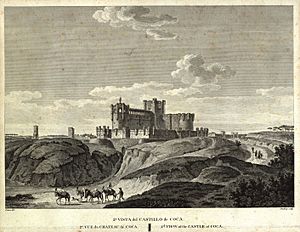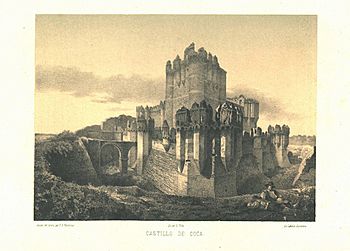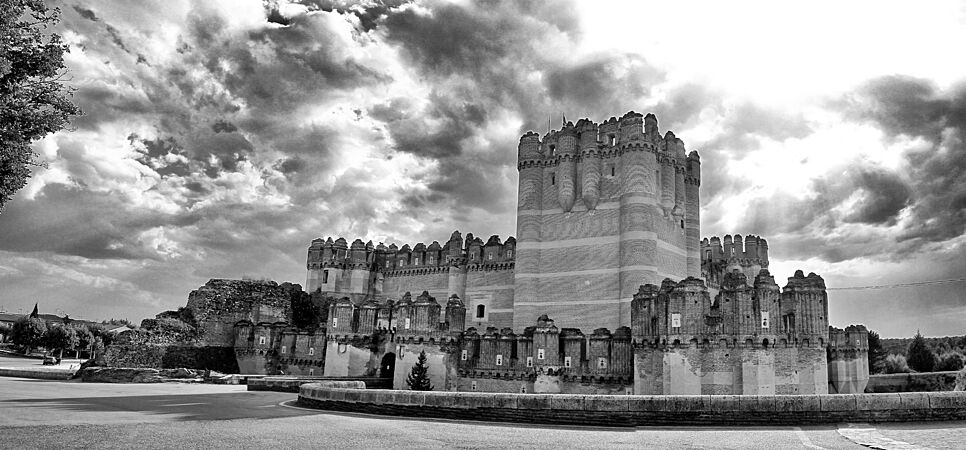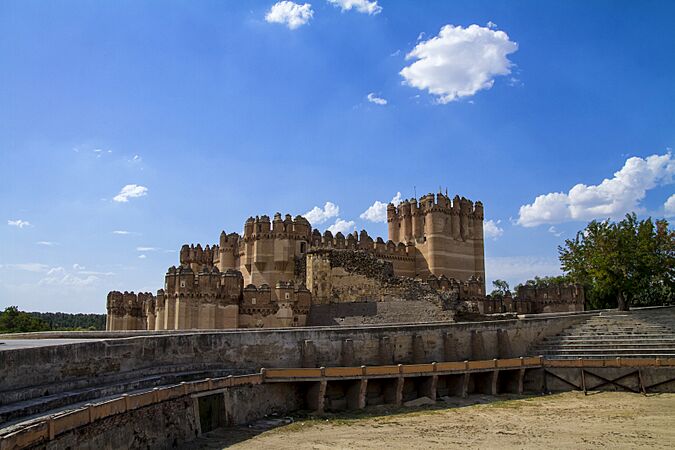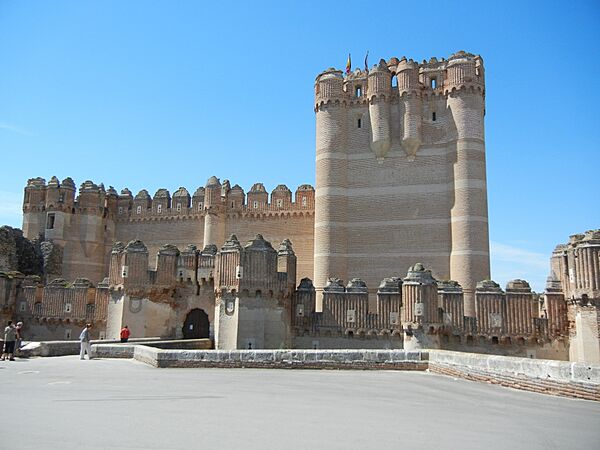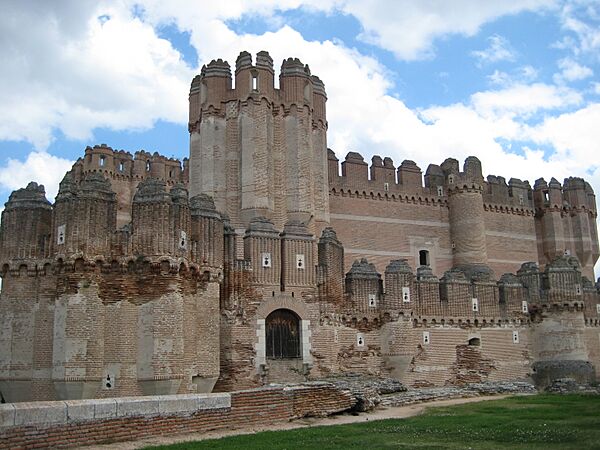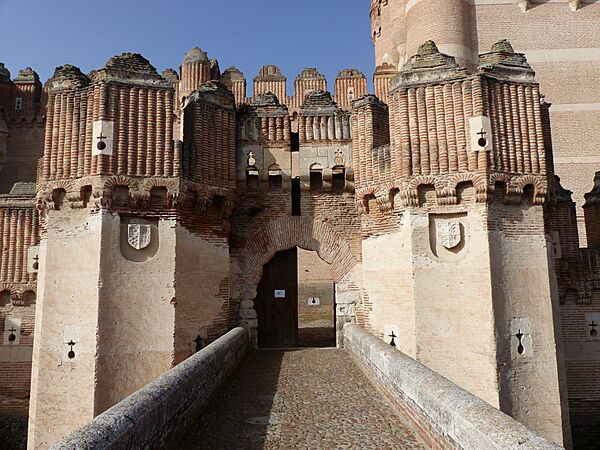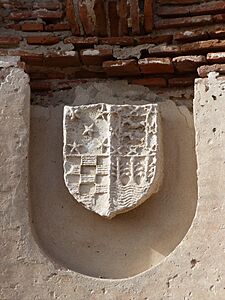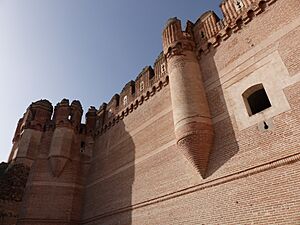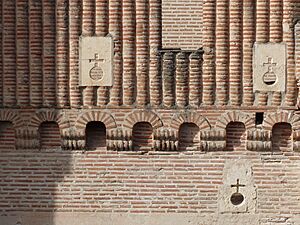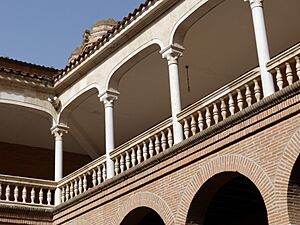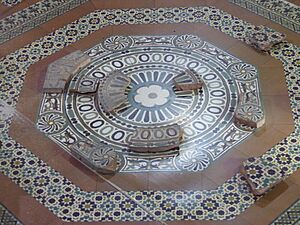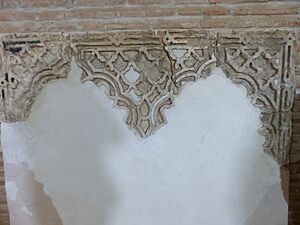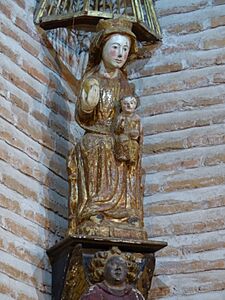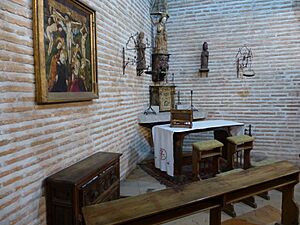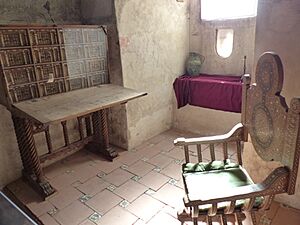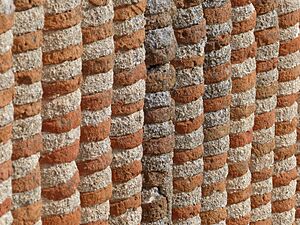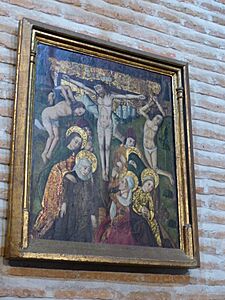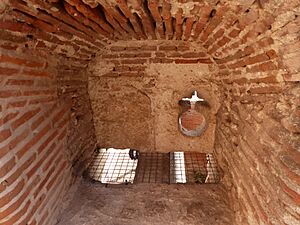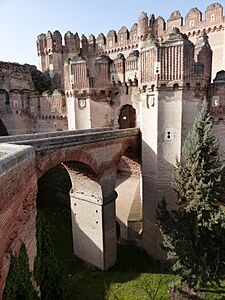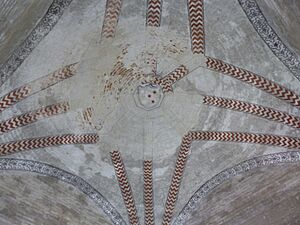Castillo de Coca facts for kids
Quick facts for kids Castle of Coca |
|
|---|---|
| Castillo de Coca | |
| Coca, Segovia, Spain | |

Castle of Coca
|
|
| Lua error in Module:Location_map at line 420: attempt to index field 'wikibase' (a nil value). | |
| Site history | |
| Built | Fifteenth century |
The Castle of Coca is an amazing castle in Coca, central Spain. It was built in the 1400s. This castle is a top example of Spanish Mudéjar style. This means it mixes Gothic architecture with cool designs from Moorish Muslim builders. You can even see a smaller copy of the castle at the Mudéjar theme park. There's also a tiny version (1:25 scale) at Minimundus miniature park in Klagenfurt, Austria.
Contents
Where is Coca Castle Located?
Coca Castle is just outside the town of Coca. This is about 45 kilometers (30 miles) north of Segovia. Most castles are on hills, but Coca Castle is different. It sits on the edge of a flat area. It looks over a bend in the River Voltoya. This river flows into the River Eresma. A deep, wide ditch called a moat protects the castle.
The town of Coca has a long history. People have lived here since 200 BC. The Roman Emperor Theodosius I was even born here!
Who Owned Coca Castle?
The famous Spanish family, the House of Alba, owned Coca Castle for a long time. They owned it until the mid-1900s. In 1954, they gave the castle to the Ministry of Agriculture. Today, it is a protected Spanish National Monument.
How Coca Castle Was Built
A Moorish architect and engineer planned the castle. These skilled builders were often hired for big projects. They were called "Alarife." Most of the castle is made of brick. But these are not normal bricks! They are very strong. They could stand up to attacks during a siege. The bricks are laid smoothly. This makes the lines of the brickwork stand out. It creates a special pattern on the castle walls.
The castle shows classic Mudéjar style. This means it uses brickwork and plaster work. These materials create cool geometric patterns. They mix Moorish Muslim and Christian Gothic architecture styles. While brick is the main material, limestone and plaster were used too. You can see them in the narrow openings for archers, called balistraria. White limestone also decorates the columns in the courtyard. It's also on the main tower, called the keep. Many other parts of the castle's outside also have limestone.
Castle Design and Defenses
The castle has a rectangular shape. It has three layers of defense. First, there's a moat (ditch). Then, there are two sets of walls. Inside these walls is the main tower, the central keep. This main tower is in the northern part of the castle. It's called the Tower of Homage.
There are two main walls around the castle. The outer wall is not complete today. You can still see parts of it. There are also some towers, some standing and some in ruins. These show where the outer moat used to be. All the outer towers were square. The second wall has a gate near the inner keep. This gate has a tall brick arch. It's framed by a special geometric border called an alfiz. This is a classic Moorish design. The inner wall has several towers too. It also has a sloped base called a talus. This sloped base goes all the way down to the moat.
The towers at the corners of the walls are square. The remaining wall has machicolations. These are openings where defenders could drop things on attackers. This, along with the sloped base, made the castle very strong. The top parts of the walls, called battlements, are also special. They are both pretty and useful for defense. They have crests that stick out from the walls. More Mudéjar brickwork can be seen here.
History of Coca Castle
Early Times
People first lived in Coca around 2,500 to 2,300 BC. There was plenty of water and good land. This made it a great place for early settlers. By the 400s AD, the village grew a lot. It became the historic city of Coca. The Romans first built the town. They called it Cauca.
In 1439, the Marquis of Santillana took control of Coca. Then, in 1451, two families started talking. These were the Santillana and Fonseca families. In 1453, they traded Coca for another town called Saldaña. The building of Coca Castle began right after this trade was official.
Medieval History
Alonso de Fonseca y Avellaneda is known for building the castle. A master builder oversaw the work. Most of the castle was finished by 1493. In 1502, a rule was made. The castle and town could only be passed down to male family members. So, after Alonso died, Antonio de Fonseca got it. In 1512, more decorations were added to the main tower. Engineers supervised this work.
The castle was attacked in 1521. This happened during the Revolt of the Comuneros. Rebel troops attacked the castle. They were angry because Medina del Campo had been burned. Royalist soldiers had attacked Medina del Campo. They burned it after facing strong resistance. In 1645, Gaspar Alfonso Pérez de Guzmán, 9th Duke of Medina Sidonia was put in prison here. He was accused of plotting against the king.
The castle was repaired many times from the 1500s to the 1700s. A notable change was adding the Patio de Armas in the 1500s. A walkway was built between the main tower and Pedro Mata Tower in the 1600s. There were also big repairs in 1715. After 1730, the castle was not taken care of. Many important items were lost or broken.
During the Peninsular War, the French army took over Coca Castle. They were there from 1808 to 1812. The castle got much worse during these four years. The French soldiers did not care for the castle. Many decorations were ruined. In 1828, the castle's manager sold off materials. The House of Alba owned the castle then. They sold columns, marble, and other parts to make money.
Modern History
Coca Castle became a national monument on August 9, 1926. The Spanish government took control of the castle. They also took the land around it from the House of Alba. No major repairs happened until 1954. That's when the government started state-funded repairs. The Ministry wanted to fix the castle. They planned to open a school for forestry training there.
The repairs were led by architect Miguel de los Santos Nicolás. His team, including Francisco Pons Sorolla, had full freedom. The renovations took four years. They finished in 1958. After the repairs, the "Escuela de Capacitación Forestal" (Forestry school) opened in 1958.
What Tourists Can See
Several rooms in Coca Castle are open for visitors. Here are some of them:
The Chapel
A fire during the French occupation destroyed the chapel's ceiling. But it was fixed later. Now, it looks completely new. The chapel has many important old art pieces. These include:
- A Byzantine Christ painting. We don't know who painted it. It's from the 1300s. It's special because Christ has a halo instead of a crown of thorns.
- Two Flemish paintings. The artist is unknown. These are from the late 1300s. The big one shows the Crucifixion. The small one shows the Annunciation.
- A tabernacle made of colorful wood. It's in the Renaissance style. On the right is a carving of San Pedro. On the left is San Pablo.
- An ivory Christ statue from the 1500s. His feet are nailed separately. He doesn't have a side wound or a crown of thorns. His head is tilted to the left.
- Two paintings of Mary the Virgin. The first is on the Altar. It's in traditional Gothic style from the 1400s. The second is Romanesque. It's on a limestone stand. It also shows the coat of arms of Castile.
The Weapons Room
You can also visit the armory. It has metal armor and weapons. These are from the 1400s, 1500s, and 1600s. The furniture in the armory is original. It's from the 1400s and 1500s. Most of it is made from walnut wood. It has columns made of bone and ivory.
The Central Keep
This is also called the Torre del Homenaje. It has a gallery and a 25-meter (82-foot) tall tower. The walkway around the walls, called 'Paseo de Ronda', connects to the keep. This area has old defense tools. These include pulleys and oil smelters.
Rebuilt Parts
When the castle was falling apart, its managers sold some columns. They did this to pay for upkeep. In 1952, eight of these columns were bought back. They cost 35,000-40,000 pesetas each. They were bought from Olmedo and Iscar. The balustrade (a row of small columns) has now been rebuilt. It looks exactly like the original.
Images for kids
- Exterior of the Castle Coca
- Interior of the Castle Coca
See also
 In Spanish: Castillo de Coca para niños
In Spanish: Castillo de Coca para niños


